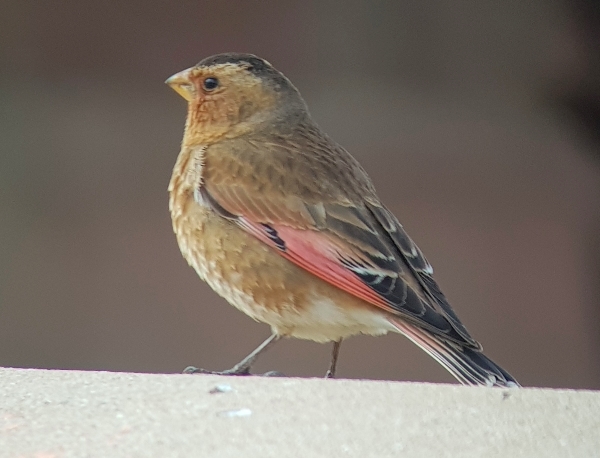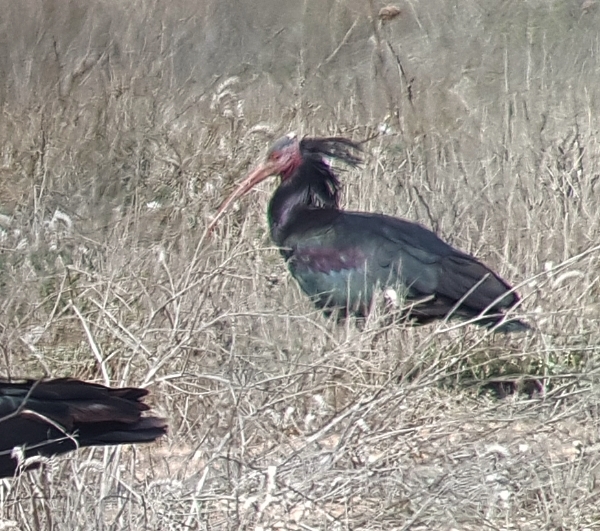Tours
- Overview/list of tour details
- SOMERSET LEVELS
- Colombia - Andean Endemics
- Sri Lanka
- Costa Rica
- Morocco
- Coto Donana and Extremadura
- Lesvos
- Lake Kerkini - N Greece
- Bulgaria
- Eastern Poland
- Extremadura & Sierra de Gredos
- Spanish Pyrenees
- Andalucia - Birds and Butterflies
- Spain - Autumn Migration I
- Isles of Scilly
- Dorset - Autumn Tour
- Gambia
- Day Tours - Spain
- Day Tours UK
Morocco
Leader: Bob Buckler
March 19th - 30th 2025
Tour Price: £1350 (s/s £150).
 Morocco is a wonderful country offering idyllic surroundings for the visiting birdwatcher with an extensive range of habitats found nowhere else in the Western Palearctic. It has vast mountain ranges, hundred of miles of steppe, semi desert scrub, palm groves, coastal mudflats, marshes and of course, the Sahara desert itself. The quiet roads lead you through fantastic scenery with a tremendous variety of landscapes that are at least, stunning, and at best breathtaking.
Morocco is a wonderful country offering idyllic surroundings for the visiting birdwatcher with an extensive range of habitats found nowhere else in the Western Palearctic. It has vast mountain ranges, hundred of miles of steppe, semi desert scrub, palm groves, coastal mudflats, marshes and of course, the Sahara desert itself. The quiet roads lead you through fantastic scenery with a tremendous variety of landscapes that are at least, stunning, and at best breathtaking.
Atlas Mountain range - Southern Morocco
This 12 day tour takes in the majestic atlas mountain range that dissects the country, we visit at a time when the peaks are snow capped, they reach over 4000 meters and offer a wonderful back-drop to the flat, stoney plains. We visit these high peaks just as the snow is receding and where Alpine Chough, Alpine Accentors and Crimson-winged Finches feed on the newly exposed scree. They are joined by Rock Sparrow, Seebohm's Wheatear and the Atlas Horned Lark, a bird that we usually associate with the winter shoreline in the eastern counties of the UK, we call it the Shore Lark.

Thick-billed Lark
The central plateau of stoney steppe, called hammada, offers an entirely new set of surroundings with miles of flat plains and wadis (dry river beds) supporting a great number of Larks and Wheatears. We will hear the fluty call of the Hoopoe Lark and search for groups of Cream Coloured Coursers with a supporting cast of Red-rumped, Desert, White-crowned and possibly Magreb Wheatears. Other Larks that we may encountered include Temminck’s Horned, Thick-billed, Thekla, Lesser and Greater Short-toed Lark. Sandgrouse can also be found, Spotted, Crowned, Black-bellied and Pin-tailed have all been recorded by Wingspan Bird Tours.

Crimson-winged Finch
Travelling further eastwards the landscape becomes more barren and palm groves begin to appear, wadis and oasis are the order of the day and in the distance, the high dune system called Erg Chebbi, is an imposing back drop. Trumpeter Finches are quite common here, we will search for Desert Warbler another speciality of the region. Bar-tailed Desert Larks can be found with Desert Wheatear, Hoopoe Lark and perhaps a flock of Blue-cheeked Bee-eaters will drop in. The Palm groves and oasis break up the regs (pebble deserts) and offer shelter to Fulvous Babbler, and Tristram’s Warbler. Many passing migrants and wintering warblers shelter in the Acacia thickets that grow along the wadis.
 |
not the most beautiful bird in the world, BALD IBIS
A visit to the numerous Kasbahs that are positioned along the Erg Chebbi sand dunes may produce the much sought after Desert Sparrow and a little further south we will visit the large seasonal lake at Merzouga (if present). In past years the lake has produced many waders and wildfowl including a flock of seventy Marbled Duck together with Shoveler, Garganey and Pintail. More recently the water has all but dreid up by the time we arrive.

Striped Ground Squirrel
An early morning 4*4 excursion into the sand dunes is a magical experience, every group that has expereinced this has expressed sheer delight, it is a wonderful trip. We look for Spotted & Crowned Sandgrouse and in 2022 we also found Pin-tailed Sandgrouse! Desert Sparrow is another main target species, never missed on our trips. The Egyptian Nightjar is also a regular sighting with the help of a local Nomad, we also see Desert Warbler, Bar-tailed Desert Lark, Hoope Lark, Wheatears, birds of prey and Brown-necked Raven. After our 3 day visit to this desert region we must bid the dunes a sad farewell and drive back south-west to visit the coastal areas around Agadir for our final few days.
After an overnight stop midway through our journey we continue westward and enter the Sous valley. This is a vast open area with large tracts of arable fields interspersed with dry scrub and hedgerows. A great number of birds inhabit this area, which include Shrikes, Black-crowned Tchagra, Moussier’s Redstart, Black-winged Kite, Common Bubul, Larks, Buntings and Storks.
Arriving late afternoon on the outskirts of Agadir we check into our hotel for a 2 night stay. From the hotel there is easy access to Oued Sous (a large river and estuary), designated a nature reserve, which can be reached within minutes from our hotel. Our afternoon visit will cover the mudflats that hold many waders, flamingos, herons, egrets and has the potential to produce rarer Terns such as Lesser Crested, Caspian and even Royal Tern. We will stay until sunset and wait for the Red-necked Nightjar to appear before returning to the hotel for a well earned dinner.
We will spend the next day visiting the superb Oued Massa nature reserve which has a variety of habitats ranging from heathland to reedbeds, Oued Massa is probably the best place in Morocco to see the enigmatic Black-crowned Tchagra. There is also a stoney plateau supporting Spectacled Warbler, Tawny Pipit, Cream-coloured Courser and Stone Curlew. The riparian woodland-scrub holds Cetti's and sometimes Moustached Warblers, also Common Nightingale, Zitting Cisticola and many passing migrants. The river itself attracts a good variety of wildfowl, gulls, terns and waders all waiting for our attention.
After lunch we travel a little further south, beyond the village of Massa, to search an area of small track-side pools and a quiet stretch of the river, this is the best place to look for Plain Martin. We may also encounter Moussier's Redstart, Moustached Warbler (very rare), Laughing Dove, Moroccan White Wagtail, Whiskered Tern, Red-rumped Swallow, Osprey and Marsh Harrier. The highlight of the day will be to visit an area where BALD IBIS feed, their colony isn't too far away and we often see them in flight too. The colony cannot be approached for obvious reasons.
After breakfast on our penultimate day we will drive north along the coastline to get better views of one of the rarest birds in the world – the Bald Ibis. Morocco supports two colonies of about 250 pairs that breed in this coastal area and if we are really lucky we may encounter a feeding party. We will also spend some time at Cape Rhir where, if the weather conditions are right, we may see a number of migrating sea-birds.
We arrive at Essaouira during late afternoon and before we check into our last hotel we will pay a visit to the mouth of Oued Ksob. There is usually a small colony of Plain Martins breeding there and with luck we should obtain good views of them. Many waders can also be found and a huge gull roost is usually located on the beach.
Finally on our 12th day we set off for our return to Marrakech, a couple of stops along the way will be made if time allows. Along this route there are good places to look for Calandra Larks, Skylarks, Lesser Short-toed Larks and other farmland species. We then set off to the airport for our return flight to London.
 |
 |
Itinerary in brief.
- Day 1 - Evening Arrival Marrakech transfer to local Hotel. (dinner not included on day 1)
- Day 2 - All day visit to the High Atlas Mounatins and the Ourika Valley. Nights at Ourika.
- Day 3 - Travel to Boumalne Dades - 2 nights Boumalne Dades.
- Day 5 - Travel to Merzouga – 3 nights Merzouga.
- Day 8 - Travel to Taliouine – nights at Taliouine.
- Day 9 - Travel to Agadir. 2 nights Agadir.
- Day 11 - Travel to Essaouira. 1 nights Essaouira.
- Day 12 - Travel to Marrakech airport for return flight to UK.
The tour cost of £1250 (single room supplement £150) includes: 11 nights half board hotel accommodation,entrance fees, all land transport and the services of the guide.
not included: Flights, travel insurance, lunches, dinner on day 1, all items of a personal nature such as drinks, alcohol, phone calls, tips and gratuities
Return airfare London – Marrakech with Easyjet will cost approx £80 - £150.
For advice on flights please call or e-mail us as shown below
FOR FURTHER DETAILS AND TO BOOK THIS TRIP PLEASE EMAIL:
info@wingspanbirdtours.com
or call us on (UK) 01935-426152, International calls +44 1935-426152
Latest Trip Reports
-
MOROCCO : Wednesday, March 20, 2024 - Sunday, June 30, 2024
Despite the extremely dry condtions and the lack of snow on the High Atlas Mountains we still managed to see 90% of the 'most-wanted' species that this tour has to offer. We had a couple of windy days in the Sahara Desert which l...
View Report -
MOROCCO : Monday, March 20, 2023 - Thursday, March 30, 2023
The weather helped the enjoyment of this tour tremdously, we had wall to wall sunshine throughout with nice temperatures. The light was perfect and our sightings terrific. We saw almost all of our target species and had great views of mo...
View Report -
MOROCCO : Saturday, March 19, 2022 - Monday, March 28, 2022
Morocco remains one the best North African destinations, it offers a huge range of habitats and stunning landscapes ranging from coastal sand dunes to snow-capped mountains and everything in between. We visited all of these habitats and&...
View Report -
Central Morocco - March 2019 : Wednesday, March 20, 2019 - Saturday, March 30, 2019
It was another very successful WINGSPAN TOUR of this beautiful part of Africa and resulted in an impressive list of nearly 200 species. The trip was made so much more pleasurable because the group were so fantastic, they gelled really we...
View Report -
Central Morocco - March 2018 : Tuesday, March 20, 2018 - Friday, March 30, 2018
A cold start to this tour saw the group wrapped up warm for the first few days. The cold weather system for this year had delayed spring migration and consequently we saw very few migrant species and no visible raptor migration. However,...
View Report
